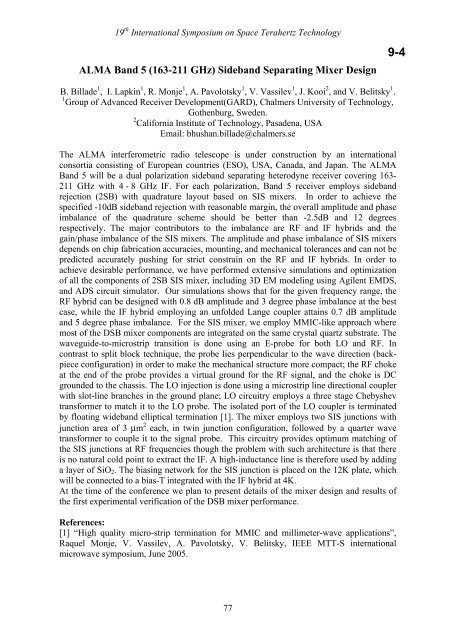Program and Abstract Book - SRON
Program and Abstract Book - SRON
Program and Abstract Book - SRON
Create successful ePaper yourself
Turn your PDF publications into a flip-book with our unique Google optimized e-Paper software.
19 th International Symposium on Space Terahertz Technology<br />
ALMA B<strong>and</strong> 5 (163-211 GHz) Sideb<strong>and</strong> Separating Mixer Design<br />
9-4<br />
B. Billade 1 , I. Lapkin 1 , R. Monje 1 , A. Pavolotsky 1 , V. Vassilev 1 , J. Kooi 2 , <strong>and</strong> V. Belitsky 1 .<br />
1 Group of Advanced Receiver Development(GARD), Chalmers University of Technology,<br />
Gothenburg, Sweden.<br />
2 California Institute of Technology, Pasadena, USA<br />
Email: bhushan.billade@chalmers.se<br />
The ALMA interferometric radio telescope is under construction by an international<br />
consortia consisting of European countries (ESO), USA, Canada, <strong>and</strong> Japan. The ALMA<br />
B<strong>and</strong> 5 will be a dual polarization sideb<strong>and</strong> separating heterodyne receiver covering 163-<br />
211 GHz with 4 - 8 GHz IF. For each polarization, B<strong>and</strong> 5 receiver employs sideb<strong>and</strong><br />
rejection (2SB) with quadrature layout based on SIS mixers. In order to achieve the<br />
specified -10dB sideb<strong>and</strong> rejection with reasonable margin, the overall amplitude <strong>and</strong> phase<br />
imbalance of the quadrature scheme should be better than -2.5dB <strong>and</strong> 12 degrees<br />
respectively. The major contributors to the imbalance are RF <strong>and</strong> IF hybrids <strong>and</strong> the<br />
gain/phase imbalance of the SIS mixers. The amplitude <strong>and</strong> phase imbalance of SIS mixers<br />
depends on chip fabrication accuracies, mounting, <strong>and</strong> mechanical tolerances <strong>and</strong> can not be<br />
predicted accurately pushing for strict constrain on the RF <strong>and</strong> IF hybrids. In order to<br />
achieve desirable performance, we have performed extensive simulations <strong>and</strong> optimization<br />
of all the components of 2SB SIS mixer, including 3D EM modeling using Agilent EMDS,<br />
<strong>and</strong> ADS circuit simulator. Our simulations shows that for the given frequency range, the<br />
RF hybrid can be designed with 0.8 dB amplitude <strong>and</strong> 3 degree phase imbalance at the best<br />
case, while the IF hybrid employing an unfolded Lange coupler attains 0.7 dB amplitude<br />
<strong>and</strong> 5 degree phase imbalance. For the SIS mixer, we employ MMIC-like approach where<br />
most of the DSB mixer components are integrated on the same crystal quartz substrate. The<br />
waveguide-to-microstrip transition is done using an E-probe for both LO <strong>and</strong> RF. In<br />
contrast to split block technique, the probe lies perpendicular to the wave direction (backpiece<br />
configuration) in order to make the mechanical structure more compact; the RF choke<br />
at the end of the probe provides a virtual ground for the RF signal, <strong>and</strong> the choke is DC<br />
grounded to the chassis. The LO injection is done using a microstrip line directional coupler<br />
with slot-line branches in the ground plane; LO circuitry employs a three stage Chebyshev<br />
transformer to match it to the LO probe. The isolated port of the LO coupler is terminated<br />
by floating wideb<strong>and</strong> elliptical termination [1]. The mixer employs two SIS junctions with<br />
junction area of 3 μm 2 each, in twin junction configuration, followed by a quarter wave<br />
transformer to couple it to the signal probe. This circuitry provides optimum matching of<br />
the SIS junctions at RF frequencies though the problem with such architecture is that there<br />
is no natural cold point to extract the IF. A high-inductance line is therefore used by adding<br />
a layer of SiO 2 . The biasing network for the SIS junction is placed on the 12K plate, which<br />
will be connected to a bias-T integrated with the IF hybrid at 4K.<br />
At the time of the conference we plan to present details of the mixer design <strong>and</strong> results of<br />
the first experimental verification of the DSB mixer performance.<br />
References:<br />
[1] “High quality micro-strip termination for MMIC <strong>and</strong> millimeter-wave applications”,<br />
Raquel Monje, V. Vassilev, A. Pavolotsky, V. Belitsky, IEEE MTT-S international<br />
microwave symposium, June 2005.<br />
77
















